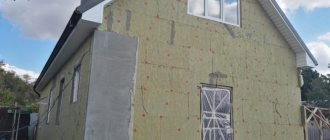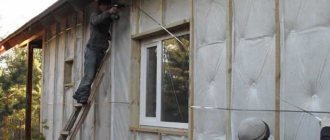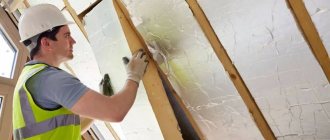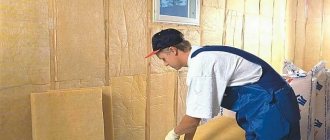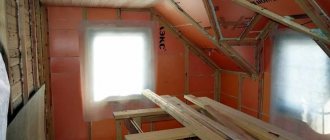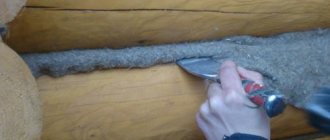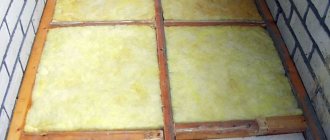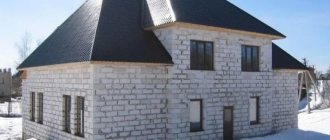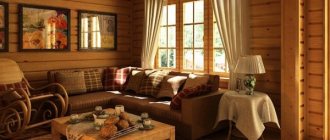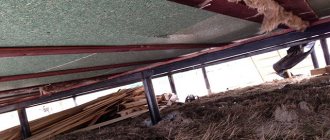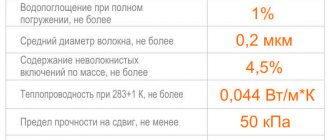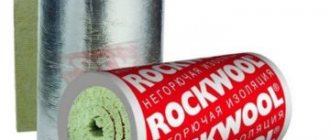Questions about how to insulate a bathhouse from the outside or inside, and how to do it correctly, have already given many sleepless nights to many owners of private households. After all, it’s no secret that in order to fully enjoy your vacation, inside a building you need an easily created and maintained microclimate that is optimal for each room. To a greater extent, it will depend on the thermophysical properties of the enclosing structures. For example, a steam room should not only heat up quickly, but also maintain the set temperature parameters for as long as possible. At the same time, you could calmly be in the rest room, covering yourself with only a towel. And even if you install a super-powerful heat generator, burn exorbitant amounts of fuel or spend extra tens of kilowatts of electricity, and leave the walls “cold” - with a high degree of heat transfer, then there will always be unpleasant drafts inside the structure.
In this article we will look at the most practical ways to insulate a bathhouse from the outside with your own hands, in which cases they are preferable to the inside, and also dispel some misconceptions on these issues. Read about thermal protection technologies from the inside on our website here.
Picture 1
How to insulate a bathhouse from the outside
To insulate a bathhouse from the outside, two technologies are used: “wet facade” and “ventilated facade”. In the first case, the thermal insulation is slabs of polystyrene foam, expanded polystyrene or basalt wool. First, they are glued to the wall with foam, additionally secured with plastic dowels and umbrellas, and decorative plaster is applied on top. In the second case, a lathing is attached to the wall of the bathhouse. The cells are filled with mineral wool or basalt slabs, covered with windproof film, and a counter-lattish is filled onto which the facing material is attached. A gap remains between the film and the lining, forming a ventilated space.
How to choose insulation
What is the best way to insulate a bathhouse? For this, natural or synthetic materials are used.
Natural insulation:
- cuckoo flax;
- red moss;
- flax tow;
- hemp hemp
- sphagnum.
These materials do not require serious material costs, are highly environmentally friendly and will help create a special atmosphere in the bathhouse, filling the interior space with natural aromas.
The main disadvantages of organic materials that need to be taken into account when choosing which insulation is best to insulate a bathhouse:
- fragility of the material;
- significant labor costs;
- the need to constantly update the insulation.
It is necessary to provide protection from small rodents, birds and insects.
Many homeowners believe that it is better to insulate a bathhouse with synthetic materials that do not rot and are not damaged by rodents.
Jute felt
What is the best way to insulate a bathhouse from the outside or the inside? Jute felt can be used as inter-crown insulation for a bath. This is an organic natural material made from plant fiber. Flax-jute felt is used not only for thermal insulation, but also to remove excess moisture from the interior of the bathhouse
To improve performance qualities, flax fiber is added to jute fibers. The result is flax wool or flax jute felt. The form of material release is tape reels. This allows you to select insulation for logs of different diameters.
Ventilated facade method
If the bathhouse is built using frame technology or the walls are made of timber or logs, the outside can only be insulated by installing a ventilated façade. For thermal insulation it is better to use basalt slabs. Rolled mineral wool sags over time, slides, and does not hold well between the sheathing elements.
Insulation from the outside begins with preparing the walls. First, they caulk the cracks and crevices between the crowns. The wood is treated with a protective impregnation. Rotten areas must be replaced. A vapor barrier is attached to the prepared wooden wall of the bathhouse.
Advice! It is better to use a special membrane as a vapor barrier for wooden bath walls.
The location of the sheathing elements is drawn using the vapor barrier material. Along the marked lines, brackets in the form of U-shaped perforated plates are attached to the walls. Pieces of roofing felt are placed under each element. The lathing is assembled from a galvanized profile or wooden blocks. The elements are fixed to perforated brackets with self-tapping screws.
When the sheathing is ready, they begin to insulate the walls of the bathhouse. Basalt wool is placed between the vertical elements. The slabs must fit tightly without gaps. The top of the insulation is covered with wind protection. The film is fixed with a stapler to the sheathing elements.
To create a ventilated space under the cladding, slats are nailed onto the vertical elements of the sheathing on top of the windbreak, forming a counter-lattice. The cladding is attached from any panels you like. To insulate the outside of a bathhouse, the Block House, which imitates a log house, is most often chosen.
Advice! If desired, the “ventilated facade” technology can be used for bathhouses made of bricks, blocks and other materials.
Selection of insulation materials
The optimal solution for insulating a bathhouse from the inside is considered to be basalt wool. Hard mats of 10 cm thickness are used. When thermally protecting the ceiling, the thickness of the thermal insulation layer should be about 15-20 centimeters, since heat loss mainly occurs through the ceiling.
To insulate the bathhouse inside, you still need to have the following materials at your disposal:
- For sheathing . The most reliable option for bath buildings made of brick or stone is to build a frame from a profile used for plasterboard (read: “How to insulate a brick bathhouse with your own hands correctly”). Often the CD ceiling profile is chosen, and the UD guide profile is used to make edging along the perimeter of the walls. The fixation step for direct hangers is from 60 to 80 centimeters. The gap between the profiles must be made smaller by 1-2 centimeters compared to the width of the insulation boards. In wooden baths, bars are used as a profile.
- For water vapor barrier . A heat-resistant material with foil is required that is impermeable to moisture and steam. There is a large selection of such products on the construction market. For example, you can purchase foamed foil polypropylene, designed for temperatures up to 150 degrees. This material is able to protect the walls of the room from dampness and reflect radiant heat, thereby reducing heat loss. Thus, a 3-millimeter thick layer of Penotherm provides the same level of thermal protection as a 150-millimeter beam.
- For finishing . Usually the insulation is placed in the bathhouse under the lining, as in the photo. This material is produced for final finishing from linden or aspen, since products from these wood species are resistant to decay processes, do not heat up even at high temperatures, and retain their original appearance for a long time.
Insulation of different types of walls
Owners sometimes insulate the bathhouse from the outside at their own discretion. The procedure is not cheap. If the cost of heat loss exceeds the cost of cladding materials, the work will have to be done.
How to insulate a wooden bathhouse from the outside
Thick walls made of timber or logs. There is no point in insulating them from the outside. Wood itself is the insulation material, plus the internal thermal insulation of the bathhouse. Walls made of timber or logs are insulated by sealing cracks. Caulk the gaps between the crowns with flax, eliminate cracks near the frames of windows and doors.
If a wooden bathhouse is made of boards or the walls are made of thin beams or logs, a ventilated façade is installed outside. Polystyrene foam and expanded polystyrene cannot be used even in this technology. The boards do not allow moisture to pass through. For this reason, they do not combine well with wood. Wooden walls will begin to rot from the vapors accumulated under the insulation. It is better to install basalt wool in a ventilated façade.
Advice! If the log house is warm but unsightly, the outside of the bathhouse can be lined with a ventilated façade without thermal insulation. Only steam and waterproofing and sheathing are attached under the panels.
Insulation of a frame bath
A special feature of frame buildings is the presence of insulation inside the walls. There is no need for additional costs for external insulation. For beauty, you can install a ventilated façade without thermal insulation. Only if the insulation inside the frame has become unusable, then a full-fledged ventilated façade with basalt slabs is installed on the outside.
Insulation of a brick bath
For a bathhouse made of brick, cinder block, foam block and other similar materials, it is advisable to insulate the outside. Preference here is given to “wet facade” technologies. Such insulation is cheaper. Budget thermal insulation is polystyrene foam. Expanded polystyrene or basalt slabs will cost a little more. The thermal insulation on top is covered with decorative plaster and painted with facade paint.
When the budget allows, the outside walls are insulated using the “ventilated facade” technology. If for a wooden bath you can only use basalt wool, then here you can lay foam or expanded polystyrene slabs between the sheathing. It is only important to seal all joints and cracks with polyurethane foam to avoid the formation of cold bridges.
Continuous external thermal insulation depending on the material of the load-bearing walls
How to insulate a bathhouse from the outside if it is not intended to seal the joints, but rather to install a thermal insulating lining? Let's look at the types of load-bearing walls:
Before insulating a bathhouse, it is necessary to correctly calculate the thickness of the insulation layer
- Brickwork or concrete structure. The types are combined into one category because they relate to inertial buildings with high heat capacity and high permissible moisture accumulation.
- Foam concrete and gas blocks. They occupy an intermediate position between log houses and brick baths.
- Log house Requires strict consideration of the relative vapor permeability of each layer of the insulating sandwich.
How to insulate a log sauna from the outside
Almost all insulation of a log bath comes down to carefully sealing the cracks. Even during construction, a special jute insulation was laid between the crowns, but over time the wood dries out, cracks, and new cracks form, which need to be caulked regularly.
Insulation of a log bath
After erecting the frame and caulking the cracks, the building must remain under the roof for at least six months. It is advisable not to use the bathhouse during this time. The log house will shrink, the wood will dry out, and new cracks and gaps will appear. These are the ones that need to be caulked. For this purpose, a special insulation based on jute and flax is used. Jute itself conducts heat poorly and does not burn, but its disadvantage is low elasticity (it tears easily). To solve this problem, flax fibers are added to the insulation for log houses. Thin strips of material are driven into the cracks using a hammer and a special metal caulking blade. This must be done carefully to prevent distortion of the structure.
There is also a special sealant for sealing cracks in wooden buildings. It’s easier to work with: a special syringe fills all available voids.
Insulating a log bath using sealant
A log house shrinks within two years. At this time, it is not recommended to cover it with finishing materials. This way you will have access to newly appearing cracks that need to be periodically sealed from the inside and outside. To protect the insulation from the effects of precipitation, the outside of the building can be covered with film, securing it with strips.
Two years after construction, you can begin finishing. For many this will sound ridiculous, but structures made of logs can be sheathed with a block house, clapboard, imitation timber, or dies. To begin with, a sheathing is mounted on the wall (if it is made of wood, it must be treated with antibacterial impregnations and increases resistance to fire), which is checked for verticality and horizontality using a building level.
Lathing for insulation and finishing
Finishing material is attached to the sheathing, which is then coated with varnish or other protective compounds. If you choose metal guides, they are mounted on special hangers.
Insulation on the outside of a log bath is almost never used, and the inside is only sometimes additionally insulated in the steam room and washing room. If you decide to play it safe and insulate the building, if the insulation is afraid of moisture, a vapor or water barrier is laid on top of it. It is secured using strips, onto which the trim is subsequently attached.
Insulation of a bathhouse made of timber from the outside
The insulation of a bathhouse made of timber from the outside is absolutely no different from the insulation of a bathhouse made of logs. The building must also stand, cracks also appear in it, which are sealed in the same way.
Insulation of a bathhouse made of timber
The need for external insulation depends on the thickness of the timber. If its thickness is insufficient for your climate zone, insulation will need to be done according to the following scheme:
- lathing made of timber or metal guides (be sure to align them in both horizontal and vertical planes);
- heat insulator (thickness depends on the climate zone, wall thickness, and type of thermal insulation);
- moisture and wind protection;
- counter lathing (not necessary, but there should be a gap between the protective film and finishing materials);
- Decoration Materials.
Insulation of a bathhouse from the outside The
outside of a bathhouse is usually sheathed from timber: clapboard of any type, edged board, siding, metal profile, block house, etc. After completion of the work, the wooden finish is coated with varnishes for exterior use, sometimes pre-treated with coloring pigments, but many modern compositions also have a tinting effect, which, of course, is convenient.
If siding is used as a finishing material, then the presence of a ventilation gap between the insulation and the finishing is mandatory. In this case, it is advisable to use special guides as lathing, which can be purchased in the same place where siding is purchased. The guides are mounted on special hangers.
Metal siding guides are mounted on special hangers
Insulation of a brick bathhouse from the outside
It is imperative to insulate a brick bathhouse from the outside - this material has high thermal conductivity, so without external insulation it will be extremely difficult to warm the room to the required conditions. The sequence of insulation is the same: frame, insulation, moisture and wind insulation, ventilation gap, sheathing.
Insulation scheme for a brick bath
For external insulation, it is usually recommended to use mineral wool. According to recent studies, they are not suitable for internal insulation of a bathhouse - they emit formaldehyde, but for external insulation they are one of the best options. You can also insulate a brick bathhouse from the outside with polystyrene foam boards, polystyrene foam (it is cheaper, but polystyrene is more durable), foam glass (its disadvantage is its high price). To ensure high-quality work, it is recommended to lay two layers intercut (offset by half the length) to reduce heat loss by overlapping the seams. But this method takes more time, and it takes twice as much materials for insulation. Therefore, most often, insulation is done in one layer, tightly laying one mat to another, and the joints are taped with reinforced tape.
Interesting: Which sauna lining is better: comparative review, features and reviews
Fabric reinforced PVC tape
To cover the outside of a brick bathhouse, you can use wooden finishing materials or siding. There is another option for exterior finishing: you can decorate the outside of the bathhouse with plaster. This is possible if polystyrene boards, foam glass or foam plastic were used as insulation. Then a reinforcing mesh is placed on top of this material, a primer is applied, and then the walls are plastered.
Scheme of insulation of a brick bath and finishing with plaster
You can insulate a brick bathhouse using the type of ventilated facade. In this case, special L-shaped brackets are attached to the wall (the installation step is 1 cm less than the width of the insulation), between which mats or insulation boards are tightly installed.
Insulation scheme for a brick bathhouse based on the principle of a ventilated facade
For reliability, they can be reinforced with special dowels, but this is not necessary - the material itself must hold quite firmly (that’s why they make the fastening step of the guides 1 cm less than the width of the insulation - it is held in place by elastic force). The joints of the slabs are glued with reinforced tape, or treated with special glue, a waterproofing film is laid on top, and secured with strips. Now guides are installed on the brackets, which support the insulation and at the same time serve as the basis for installing the exterior trim. Using this scheme, you can also insulate baths made of foam blocks, cinder blocks or aerated concrete.
Finishing the outside of a bathhouse made of blocks
Any of the insulation schemes described above can be applied to block baths. In addition, there is another option: to cover such a bathhouse with decorative bricks, but this option of finishing and insulation is possible if the temperature in the bathhouse is maintained above zero at all times.
Exterior decoration of the bathhouse with decorative bricks
If you decide to line a bathhouse made of blocks with bricks, you can lay out the second wall not closely, but retreating 5-10 centimeters. In this case, the thermal insulation characteristics of the building will be much improved. The gap can be left empty, or it can be filled with thermal insulation material: expanded clay, sawdust that has undergone special treatment, etc.
Insulation scheme for aerated concrete baths
To prevent moisture from accumulating in the space between the walls, small ventilation gaps are left in the outer wall, and to securely fix the finishing wall, small pieces of fastening reinforcement are driven into the load-bearing wall.
Recently, finishing material such as a block house, which emits a log wall, has become increasingly popular. Block houses are made from different materials: PVC (vinyl), metal or wood. A bathhouse made of blocks, lined with a block house, looks as if it is made of wood.
Block bathhouse covered with a block house
How to insulate a bathhouse ceiling from the outside
Inside the bathhouse, the ceiling is insulated in the same way as the walls, and a ventilated space is provided. From the outside of the attic, another technology is used. When the rough board ceiling is lined, it is covered with two layers of fiberglass. It is not advisable to use roofing material, since heating will cause an unpleasant smell of bitumen to appear inside the steam room.
Even rolled mineral wool can serve as thermal insulation, but in order to save money, natural materials are used for insulation. The space between the beams is filled with expanded clay. Kneading clay with the addition of fine straw, shavings, and sawdust is suitable.
When the clay pouring hardens and dries, slabs of polystyrene foam or expanded polystyrene are laid on top. The thermal insulation is covered with waterproofing, and a thin concrete screed is poured. You can even walk on this surface. If the attic of the bathhouse is allocated for a rest room, after insulation the final layer is laid on the finished floor.
Myths about the purposes and results of external insulation
You can often find the following statements in informational texts and forums:
- “A brick bathhouse must be insulated from the outside. Otherwise, heating it to the required temperature will be problematic.” Note: the speed of heating a steam room depends to a much greater extent on the proper arrangement of internal insulation.
- “For polystyrene foam, it is best to use the “wet facade” finishing system so that the wall “breathes.” Note: EPS boards have practically zero vapor permeability, which cannot be increased by any coatings.
- “You can buy foam glass granulate relatively cheaply and use it as a filler for heat-saving cladding blocks.” Note: such granulate, both in the form of backfill and as the basis for the formation of cellular concrete, is an order of magnitude inferior to the heat-shielding properties of block foam glass. In fact, it is no better than expanded clay.
Is it necessary to insulate the foundation of a bathhouse from the outside?
To make sure of the importance of external foundation insulation, it is worth considering 5 reasons:
- On a cold foundation in winter, a temperature difference forms in a heated bathhouse. The resulting condensation destroys the concrete base.
- The problem with condensation occurs even in summer. An uninsulated foundation is heated by the sun from the outside, but the cold and moisture of the earth is drawn from the inside. The temperature difference is similar.
- A foundation that is not insulated from the outside cools the steam room faster. The bathhouse has to be heated more often.
- On the outside, thermal insulation in winter softens the impact of heaving soil on the foundation.
- A thick layer of thermal insulation on the outside protects the foundation from destruction and accidental mechanical influences.
The listed 5 reasons convince us that insulating the foundation of a bathhouse from the outside is necessary. It can be carried out simultaneously with thermal insulation from the inside. It is impossible to do only internal insulation of the base of the bathhouse. Due to temperature changes, concrete will begin to collapse on the street side.
How to insulate the foundation of a bathhouse from the outside with your own hands
There are different ways to insulate the base from the outside. They all depend on the type of soil where the bathhouse is built, as well as on the design of the foundation itself.
The strip foundation is dug around the outside with a trench 50 cm wide. The depth is maintained at least 80 cm. A 20 cm layer of sand is poured into the trench. The concrete strip is cleaned of dirt and treated with hot bitumen. After the waterproofing has hardened, the base is covered with polystyrene foam or polystyrene foam. Plates 15 cm thick are glued with foam and additionally secured with dowels and umbrellas. When using expanded polystyrene, the gap between the trench wall and the insulation is filled with sand. The foam is covered with a brick wall. From above, the entire pie around the base is filled with a concrete blind area at an angle of 15 degrees.
A monolithic foundation is usually laid under a bathhouse in a swampy area. The base is insulated during the construction stage. Expanded polystyrene is embedded between the layers of concrete screed. On the walls outside the foundation of the bathhouse, insulation with your own hands occurs according to the principle of a strip base.
The columnar foundation creates a gap between the soil and the lower crown of the bathhouse. To insulate it, it needs to be bricked. First, a trench is dug along the perimeter of the bathhouse. The parameters are the same as for insulating a concrete strip. The bottom of the trench is covered with a 25 cm layer of sand and filled with water. When the pillow is compacted, they begin to lay out the wall. Concrete can be poured up to the ground level, and rows of bricks can be laid above. A gap is left between the last row and the crown of the bath and filled with polyurethane foam. The built base is insulated from the outside using the strip foundation method.
Tips and tricks
- First of all, do not forget that heated air masses can exit the bathhouse through the windows. And for this reason, you should give preference to small windows. What is also important, experts recommend, if possible, installing frames with more than one double-glazed window. And it is best to have 2 or 3 double-glazed windows (the more, the better, because this will prevent the rapid evaporation of warm air from the bathhouse).
Small window in the bathhouse - photo
- Doors and thresholds have an important influence on the thermal insulation in your bathhouse. Quite often, specialists are contacted with the problem of rapid evaporation of air from the bathhouse. And the reason for this in 90% is the gap between the threshold and the door, due to which all the heat evaporates. To be sure that you will not encounter a similar problem, it is best to install low doors with a high threshold.
It is recommended to install small doors with a high threshold
- Due attention should be paid to the heater. After all, the intensity of heating the bath and how long the warm air will be retained in it will directly depend on the heat capacity of the stones.
Stove-heater
Insulating a bathhouse from the outside with your own hands
External insulation work can be divided into three stages: preparation, rough work, final cladding.
Surface Requirements
Regardless of the chosen insulation method, the outside walls of the bathhouse must be carefully prepared. The surface is thoroughly inspected. On wooden walls, cracks are caulked with jute or flax.
The gaps between the crowns of the log house can be sealed with modern materials. The area is first primed. The gaps are pushed in with polyethylene foam cord, and sealant is applied on top.
The sealing method depends on the packaging of the paste. The sealant is applied from buckets with a spatula, and squeezed out of tubes with a pistol. When using a special tape, remove the protective film from its adhesive layer. Cover the area with a strip. The top of the tape is rolled with a roller. The restored wooden surface is treated with a protective impregnation.
The preparation of brick and block bathhouse walls is based on sealing all cracks and potholes. Small gaps are filled with sealant. When using putty or cement, the groove is widened so that the solution penetrates deeper into the crack.
Tools
The set of tools depends on the selected material for the work. If you choose a ventilated facade for installation, you will need a saw, drill, jigsaw, hammer, and screwdriver. To install a wet facade, you need spatulas, buckets, and a construction mixer.
Installation
External insulation using the “ventilated facade” method consists of the following steps:
- a sheathing is attached to the wall of the bathhouse (the wooden structure is first sheathed with a vapor barrier);
- the cells are filled with insulation;
- the windproof film is applied to the sheathing using a stapler;
- a counter-lattice is attached from slats.
The entire cake is covered with facing material.
External insulation using the “wet facade” method consists of the following steps:
- slabs of polystyrene foam, expanded polystyrene or basalt wool are glued to the wall with an adhesive composition;
- square thermal insulation slabs are fixed at 5 points with dowels and umbrellas;
- the insulation is covered with a base layer of plaster, and the fiberglass mesh is fixed.
The final finishing is decorative plaster. The method of application depends on the chosen composition.
Thermal protection method
You can insulate the foundation in two ways - before and after laying. The first method is used before pouring cement. Insulation materials are laid on the outside of the foundation wall above the ground and underground (if there is a tunnel). The insulation of the underground part of the foundation block in contact with the ground is additionally covered with a protective layer. If the foundation block is shallow, its base is also subject to thermal insulation.
After casting the cement mortar, in addition to finishing the interior with heat-insulating material, a blind area is laid - the outer layer that holds the base. Before filling the blind area, a heat-retaining layer is laid under it.
Often builders use formwork instead of an insulating layer. The structure is mounted not from wood, but from polystyrene foam. Therefore, it does not need to be removed after the concrete solution has dried. It is a good thermal insulation material and does not deteriorate under the influence of environmental factors. Wooden boards, unfortunately, are susceptible to rotting.
The second method is used after the construction of the building. In essence, it is equivalent to insulating the height of the base. The base, as with internal insulation, is protected with a blind area. This method is simpler, more economical, but less effective, since it is applied only to the front side of the foundation.
Video description
How to properly perform herringbone cladding, watch the video:
- Cladding with strips.
In this case, the vertical direction of fastening to the horizontal sheathing is preferable. The boards are attached to it with indentations from each other, after which the resulting gaps are covered with the next row of boards. The result is a staggered installation. It looks quite interesting and unusual, especially when using unedged boards.
Vertical cladding of a bathhouse with unedged boards with flashings Source ibb.co
Facade panels
If you do not have financial problems, you can cover the outside of the bathhouse with more expensive and solid materials used for finishing the facades of residential buildings. This may be justified if you want to give all buildings on the site a uniform look and style.
Such materials include various facade panels made of composite materials - fiber cement, vinyl, WPC, clinker, etc.
- WPC panels.
WPC is a wood-polymer composite made from wood flour and a polymer binder in different proportions. Such panels are characterized by high strength, low thermal conductivity, wear resistance, they do not deform, do not rot, and are easy to clean. Available in the form of hollow boards with a hidden installation system. Costs may vary depending on the percentage of components. On average it is 1200-1400 rubles/m².
WPC facade panels Source gardeck.ru
Video description
We recommend seeing how to properly sheathe frame buildings with wood:
It is important! Before installation, antiseptic compounds should be used to impregnate not only the cladding panels, but also the sheathing slats and other wooden structures hidden under the cladding.
The installation principle is that after installing the first board level, it is fixed on the groove side with nails driven at an angle or with clamps and self-tapping screws. Then the tenon of the next panel is tightly inserted into this groove and, after checking the level, secured in a similar way. This is how the cladding is installed along the entire height or length of the wall.
Internal and external corners, framing of openings are made of polished edged boards.
Upon completion of finishing, the facade is decorated with tinted impregnations, varnishes or acrylic paints for exterior use.
When choosing what you can use to cover the outside of a bathhouse inexpensively, it is worth considering options for finishing it with regular boards - edged or unedged. There are at least two ways to create attractive and practical facades from them.
- Herringbone paneling.
This method involves horizontal installation of boards with overlap. The bottom board is attached to the sheathing level, and each subsequent board is laid on it with its lower edge and fixed through with galvanized nails or self-tapping screws.
Facade cladding
Its functions are protective and decorative. It protects all internal layers from natural factors (UV radiation, precipitation, wind), as well as artificial mechanical influences.
It is worth adding that Figure 5 shows how to insulate a wooden bathhouse using ventilated facade technology. For walls made of brick or aerated concrete blocks, the scheme will be similar. In addition, the energy-saving system based on wet facade technology is in no way inferior in its thermophysical properties (Fig. 6). In this case, the functions of wind, hydro, mechanical protection and decorative coating are assigned to special vapor-permeable plasters. Nevertheless, for bathhouses built from wood materials, which are the majority in Russia, a ventilated coating is still preferable.
Sources
- https://2proraba.com/banya/kak-uteplit-banyu-snaruzhi-svoimi-rukami.html
- https://banyaspec.com/otdelka/kak-sdelat-uteplenie-parnoy-pravilno-i-kakie-materialy-ispolzovat.html
- https://stroymasterok.com/banya/naruzhnoe-uteplenie-bani-texnologii-vybor-materiala/
- https://gipsohouse.ru/bazaltovyj-vata/18367-za-chto-vybirayut-i-kak-primenyayut-bazaltovuyu-vatu-dlya-utepleniya-bani.html
- https://mr-build.ru/newteplo/uteplenie-bani-snaruzi.html
- https://m-strana.ru/articles/kak-uteplit-parilku-v-bane-iznutri/
- https://banya-expert.com/uteplenie/uteplenie-sten-bani-iznutri-i-snaruzhi.html
- https://2proraba.com/banya/uteplenie-parilki-iznutri.html
[collapse]
